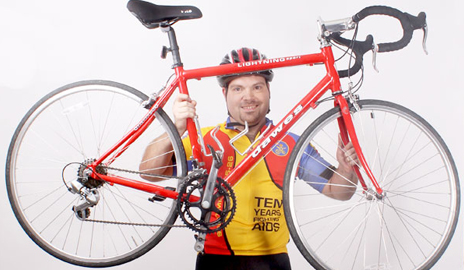LSR much deeper than a dare for rider representative — even if it started that way
M.M. ADJARIAN | Contributing Writer
If there’s one thing David Smith has learned, it’s this: Never underestimate the power of a barroom promise made in the presence of a friend with a videophone.
Thanks to both — the promise and the incriminating recorded evidence — Smith had all the incentive he needed to sign up for the 2010 Lone Star Ride.
Not that Smith wouldn’t have signed up for the Ride … eventually. But as it so happened, the person who recorded the IT consultant’s vow was in the process of training for the event himself.
“And I said, ‘You know, I might like to do that one of these days,’” recalls a grinning Smith. “That’s when he made me commit to it.”
His reasons for participating in the Lone Star Ride go much deeper than simply wanting to follow up on a dare, though. He’s seen firsthand just what the funds raised through the event can do for people in need of HIV and AIDS services.
“I’ve had numerous friends over the years who’ve come in contact with the three [agencies the Ride benefits],” he says. “And I’ve seen through them a lot of what the LSR does for the community.”
Smith is also a man of conscience. He came out in the late 1990s, just as the worst of the AIDS epidemic had passed. By contrast, his partner, who’d been out since the late 1980s, had directly witnessed the devastation AIDS had wrought in the gay community.
“I see the emotion in his eyes when he talks about losing [so many] of his friends to the [disease],” says Smith, his voice breaking. “And so I feel like since I wasn’t there to see that, this is my way of giving back.”
He also believes that the LSR is an important symbol, especially for LGBT youth and young adults. Despite the great strides medical researchers have made in combating the AIDS virus, the epidemic continues.
“When you see advertisements for HIV medicines in magazines today,” he remarks, “you always see very healthy people. But in the ’90s, you’d see people moving past the bars down Cedar Springs with walking canes or in wheelchairs. [Twenty-somethings] have no idea what it means to have to go through that.”
Prior to joining the LSR in 2010, Smith had been one of the many casual cyclists you often see riding around White Rock Lake on any given day. He has since traded in his $200 bicycle for the leaner, meaner road bike he initially borrowed from the LSR Locker, but which he now owns.
Participating in the Ride for just one season has also converted Smith into a committed LSR volunteer: He is now LSR’s rider representative. Part of his work involves counseling new cyclists, especially those feeling uncertain about their ability to do the event.
Says Smith, “People ask me, ‘How can you ride 40, 50 or 60 miles — that’s just too far!’ But if you’ve ever ridden your bike once around White Rock Lake, which is just shy of 10 miles, you [begin to] realize just how easy it is to do.”
As the LSR rider rep, Smith also leads individuals and groups on unofficial training rides.
“One of the things I learned along my training path was that if I’m riding with somebody, it’s easier than if I’m riding by myself,” he explains. “Their energy pulls you along and yours pulls them along.”
And that energy is crucial, especially for new riders who haven’t attempted long distances before.
“There’s a [back-and-forth] mental argument you end up having with yourself,” Smith says. “It goes something like this: ‘No, you can’t give up’ and, ‘It’s too far.’ But if you push, you do get there.”
Smith pauses and smiles. “And then you realize — wow, it wasn’t as hard as I thought it would be.”
Lone Star Ride Fighting AIDS takes place Sept. 24-25. For details or to donate to a specific rider or team or to the ride in general, go online to LoneStarRide.org. If you are interested in talking to David about the ride or want to schedule an unofficial training session, you can contact him at david@davidsmith71.com.











